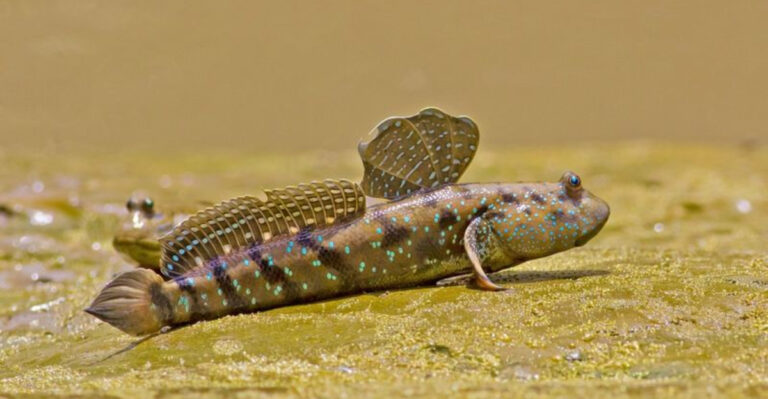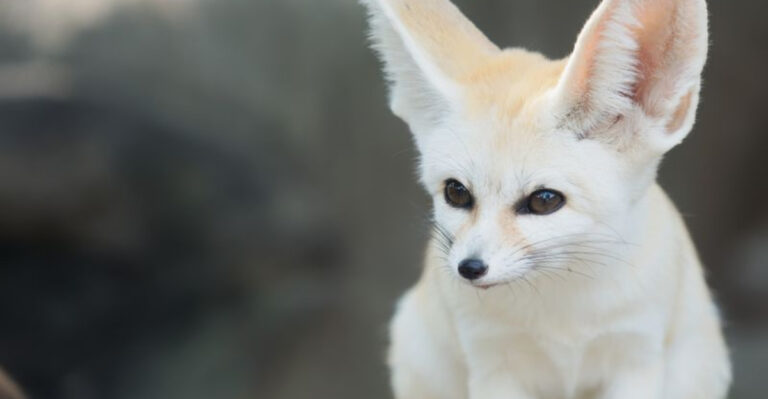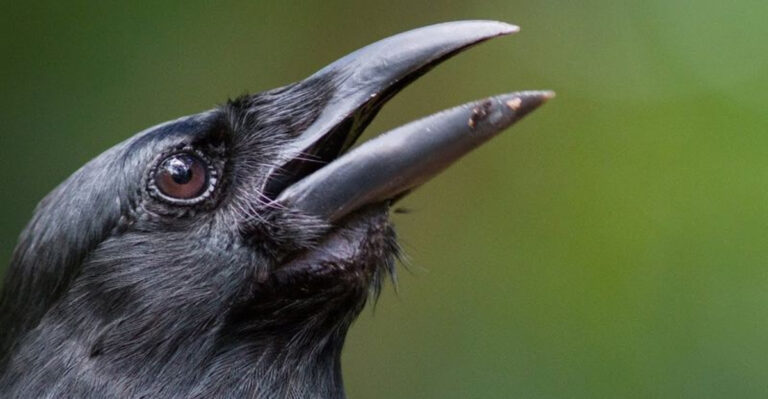18 Incredible Marine Creatures The Mimic Octopus Can Imitate
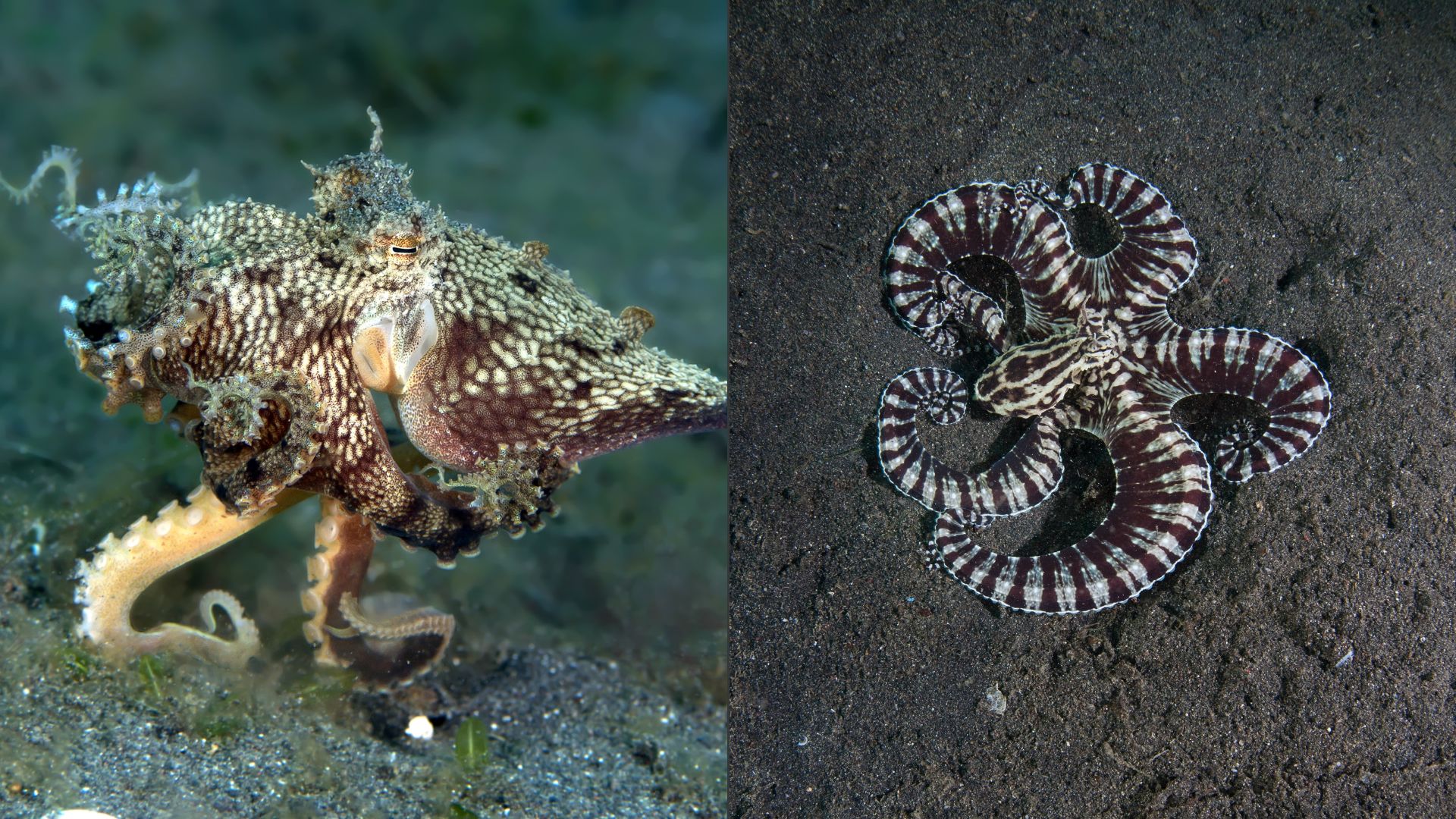
The Mimic Octopus, a master of disguise, is renowned for its remarkable ability to mimic a wide array of marine creatures.
This fascinating cephalopod, found in the tropical waters of Southeast Asia, can assume the appearance and behaviors of various sea animals to evade predators and surprise its prey.
From venomous lionfish to the formidable stingray, the Mimic Octopus showcases an extraordinary repertoire of imitations that intrigue marine biologists and ocean enthusiasts alike.
In this article, we’ll explore some of the most incredible creatures this talented octopus can emulate, each with its own unique characteristics and survival strategies.
1. Lionfish

The Mimic Octopus can transform itself into a venomous lionfish, a creature known for its striking zebra-like stripes and long, venomous spines.
By spreading its arms and undulating them like the lionfish’s spiny fins, it deters predators who fear the painful sting. This mimicry is not just about appearances; the octopus also imitates the lionfish’s slow, deliberate swimming style.
This imitation is particularly useful in regions where lionfish are common, as predators have learned to avoid them due to their venomous nature.
The Mimic Octopus’s ability to adopt the lionfish’s form is a testament to its understanding of the marine food chain. The lionfish defense strategy offers the Mimic Octopus a clever way to navigate the dangerous oceans while conserving energy and keeping threats at bay.
2. Flatfish
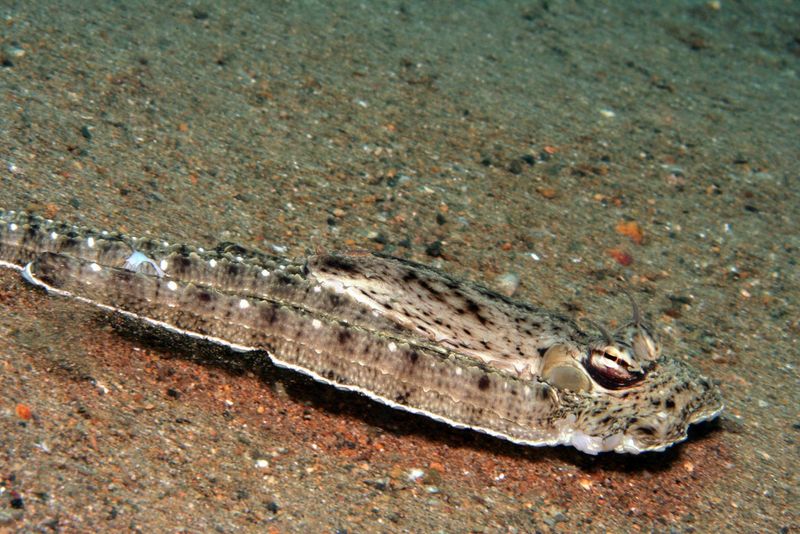
One of the Mimic Octopus’s most fascinating imitations is that of a flatfish, which involves flattening its body and gliding along the seabed. By aligning its arms and body into a flat, wide shape, it closely resembles a flatfish, such as a sole or flounder, both of which are known for their remarkable camouflage abilities.
This mimicry allows the octopus to traverse open areas with less risk of detection. The flatfish imitation is not only about blending in with its surroundings; it also mimics the flatfish’s movements. This is an ingenious tactic for avoiding predators that prefer not to eat flatfish due to their texture and taste.
The Mimic Octopus’s ability to convincingly imitate a flatfish demonstrates its versatility and adaptability in the wild, making it one of the most intriguing creatures in the ocean.
3. Sea Snake
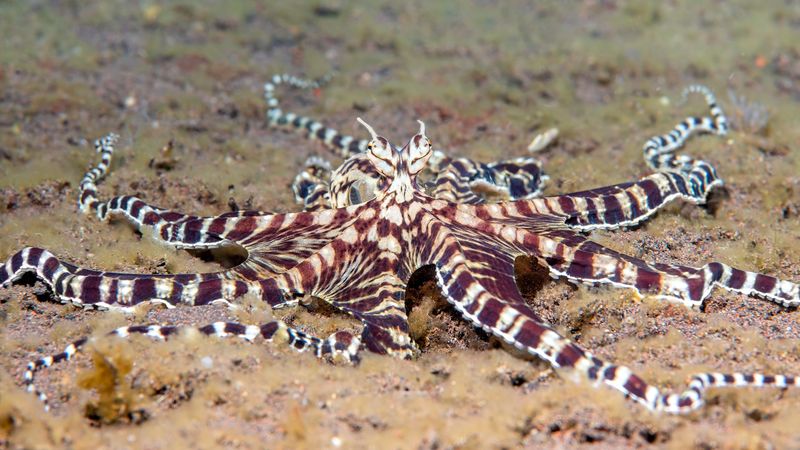
Among its repertoire, the Mimic Octopus can imitate the highly venomous sea snake, specifically the black and white banded sea snake. By threading its arms back and forth in a serpentine motion, it creates the illusion of a sea snake slithering through the water.
This form of mimicry is particularly effective against predators unfamiliar with the octopus’s trickery. Sea snakes are generally avoided by many marine animals due to their potent venom, which makes this imitation a brilliant survival tactic.
The Mimic Octopus uses this imitation to navigate through potentially dangerous areas without harm. By mimicking such a feared creature, it benefits from the sea snake’s ominous reputation, showcasing the octopus’s ability to adapt and thrive in its underwater environment.
4. Jellyfish
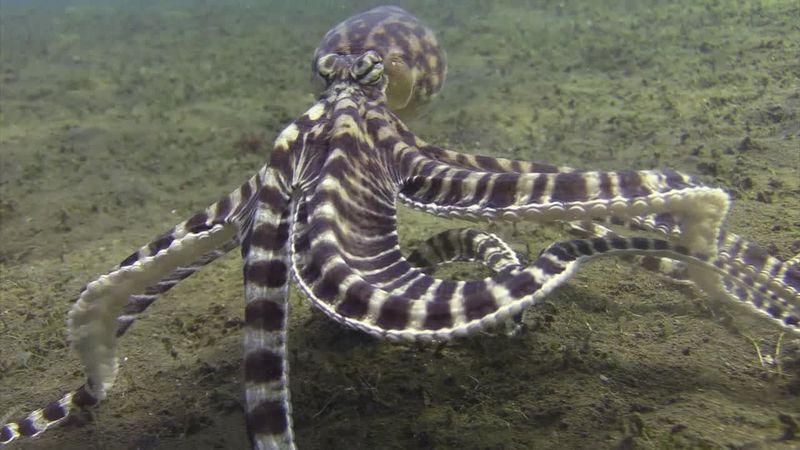
The Mimic Octopus can take on the appearance of a jellyfish, a creature known for its ethereal beauty and stinging tentacles. By extending its arms upward and trailing them like a jellyfish’s tentacles, the octopus can convincingly glide through the water as if it were one of these gelatinous beings.
Jellyfish are often avoided by predators due to their painful stings, which makes this imitation a clever defensive maneuver. The Mimic Octopus doesn’t just mimic the jellyfish’s appearance; it also replicates its graceful floating motion.
This ability to transform into a jellyfish allows the octopus to exploit the natural fear of jellyfish stings, providing it with an effective means of protection in its natural habitat. It’s a testament to the octopus’s intelligence and adaptability in using available resources to ensure its survival.
5. Crab
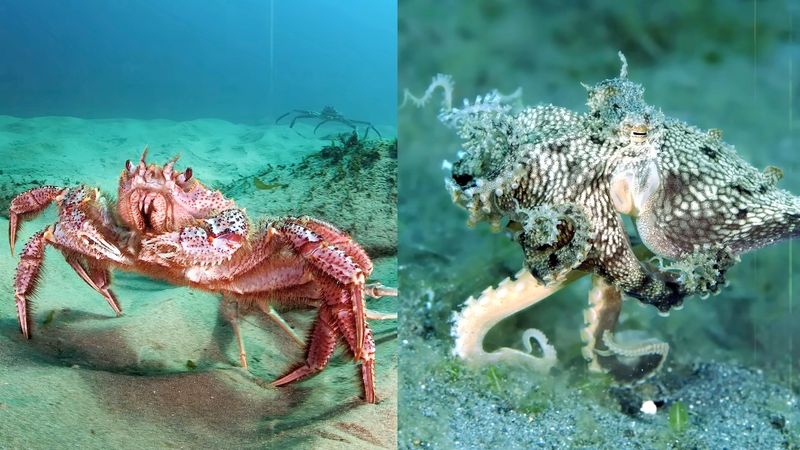
The Mimic Octopus has the remarkable ability to imitate a crab, a common inhabitant of the ocean floor. By contorting its body and arms, it can adopt the crab’s distinctive sideways scuttle, complete with the appearance of jointed legs.
This imitation is not merely a disguise; it also includes mimicking the behavior of crabs, which often involves abrupt stops and sudden changes in direction. Such mimicry is advantageous because many predators are familiar with crabs and may not view them as a primary food source.
In regions where crabs are abundant, the Mimic Octopus leverages this guise to move about without attracting unwanted attention. This imitation is a brilliant example of the octopus’s ability to deceive and protect itself by blending seamlessly into its environment.
6. Manta Ray
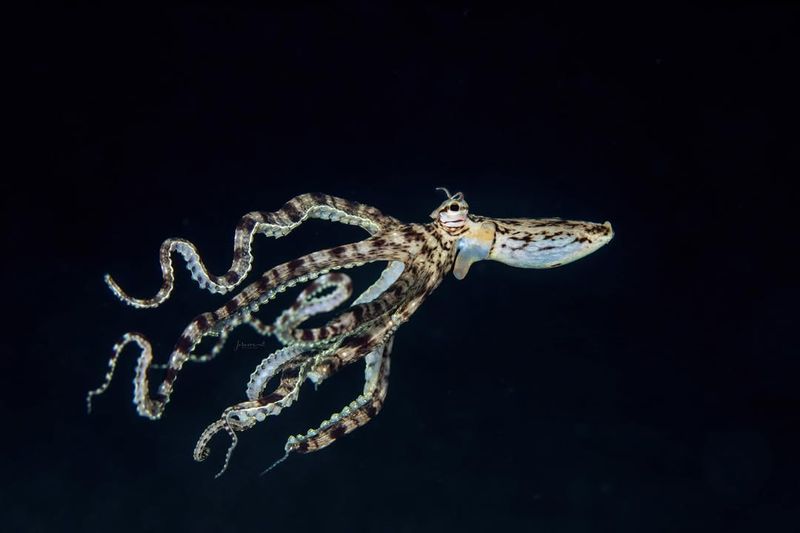
One of the more majestic creatures the Mimic Octopus can imitate is the manta ray, a gentle giant of the sea. By flattening its body and extending its arms like the wing-like fins of a manta ray, the octopus can replicate the ray’s graceful gliding motion through the water.
This imitation is particularly effective in open water, where the silhouette of a manta ray can deter potential threats. The gentle nature of manta rays and their size make them less likely to be targeted by predators.
The Mimic Octopus uses this ability to navigate the ocean with a sense of calm and authority, relying on the manta ray’s peaceful image to avoid confrontation. This imitation highlights the octopus’s ability to utilize peaceful creatures’ characteristics for its survival strategy.
7. Starfish
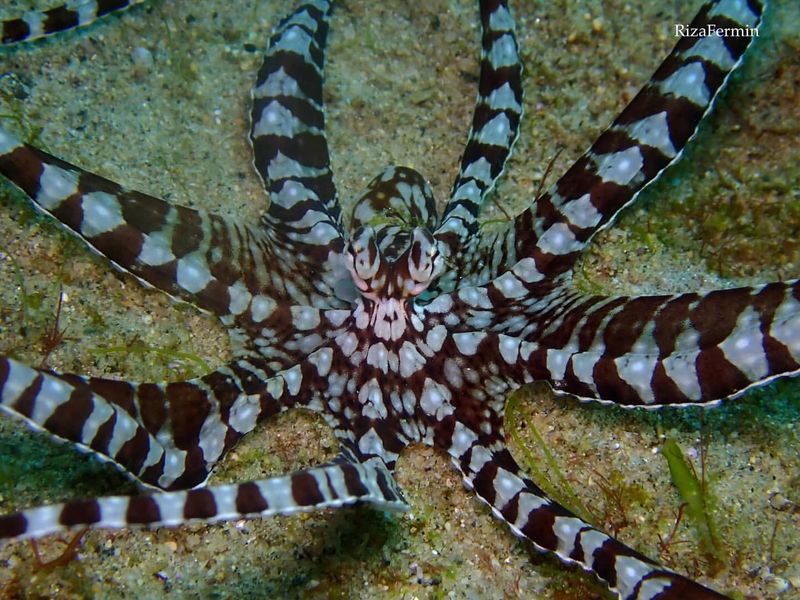
The Mimic Octopus’s imitation of a starfish is both simple and effective. By aligning its arms into a star-like formation and remaining still, it can easily resemble a starfish, a creature often overlooked by predators due to its hard, inedible exterior.
This transformation is not just about shape; the octopus can also mimic the texture and color patterns of a starfish, blending seamlessly into its environment. This can be especially useful in rocky tidal pools, where starfish are commonly found.
This imitation is a brilliant tactic for the Mimic Octopus, allowing it to rest and observe its surroundings without drawing attention, proving once again its strategic use of mimicry as a survival tool in the diverse marine ecosystem.
8. Stingray
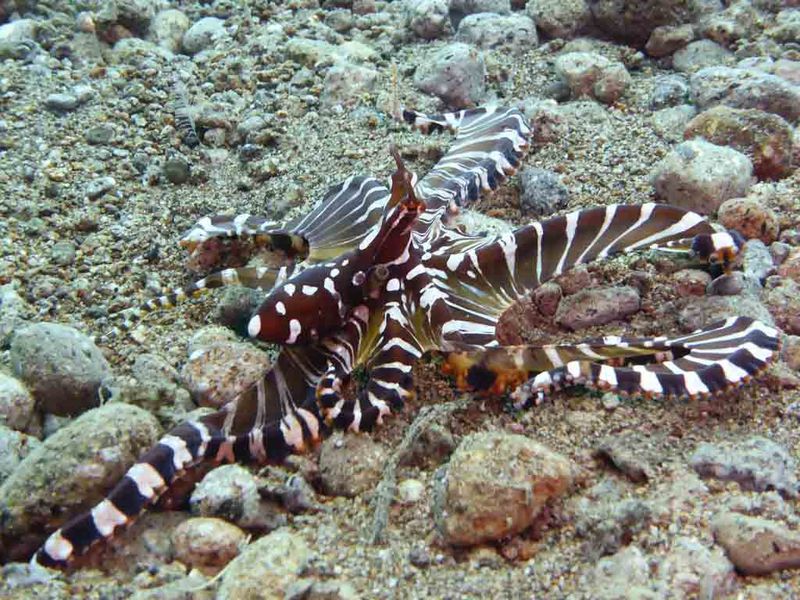
The Mimic Octopus can deftly imitate a stingray, a creature known for its distinctive flat body and long, venomous tail. By spreading its body wide and mimicking the stingray’s swimming style, it can glide along the ocean floor just as a stingray does.
This imitation serves as an effective deterrent to predators, as stingrays are often avoided due to their defensive capabilities. The octopus’s ability to replicate the stingray’s movements is not just about avoiding predators but also moving around undetected.
The Mimic Octopus’s stingray impersonation is a testament to its skill in adopting the characteristics of creatures that command respect in the ocean, using their powerful defenses to its advantage in the intricate marine world.
9. Octopus
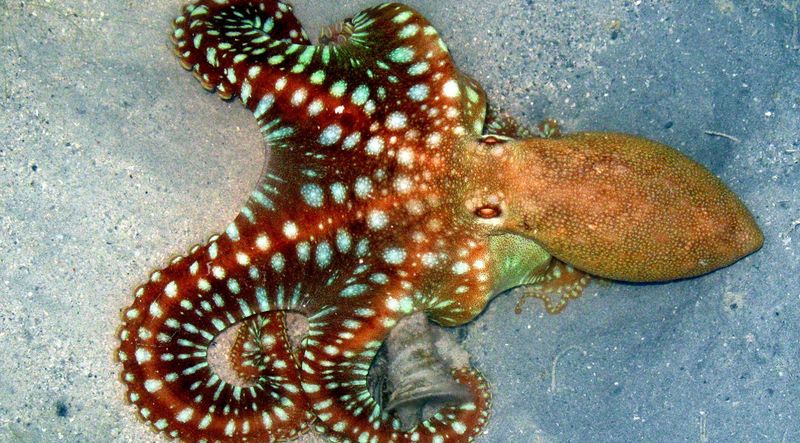
In a delightful twist, the Mimic Octopus can also impersonate one of its own—another octopus. By altering its color and texture to match the surroundings, it can convincingly blend in as a common octopus.
This imitation allows it to hide in plain sight among coral reefs or rocky crevices, utilizing its natural camouflage abilities. The mimicry of another octopus demonstrates its understanding of the shared predatory threats and the need for stealth.
The ability to mimic an octopus provides the Mimic Octopus with the flexibility to adopt a low-profile presence, ensuring it remains undetected by both prey and predators. This versatile skill underscores the depth of its adaptive strategies in the wild.
10. Giant Cuttlefish
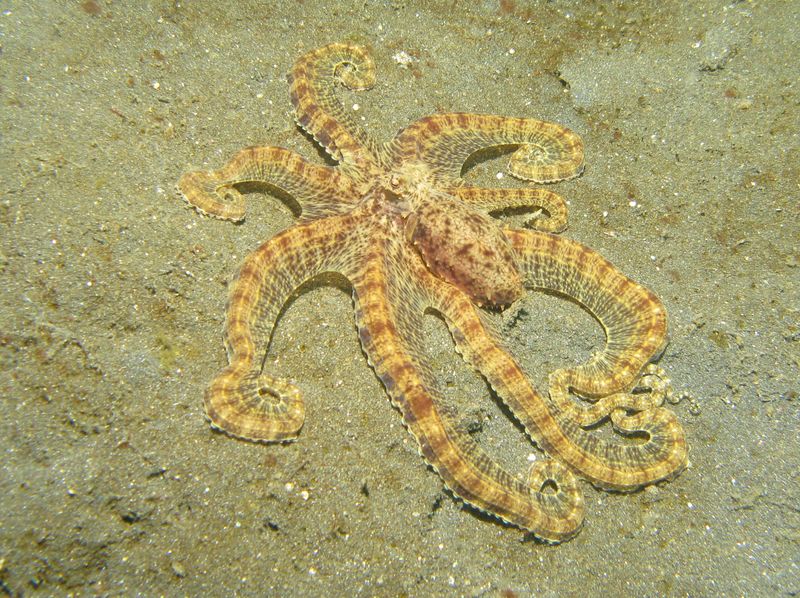
The Mimic Octopus can emulate the appearance and movements of a giant cuttlefish, a master of camouflage and color change. By altering its skin texture and patterns, the octopus can resemble the cuttlefish’s vibrant display.
This imitation is particularly effective in regions where cuttlefish are common, as it allows the octopus to blend into coral reef environments with ease. The Mimic Octopus mimics the cuttlefish’s behavior, including its undulating fin movements and color shifts.
By adopting the guise of a giant cuttlefish, the Mimic Octopus can navigate complex coral habitats while avoiding detection. This imitation showcases the octopus’s ability to exploit the natural skills of other cephalopods, enhancing its own survival prospects in the ocean.
11. Sand Anemone

In a surprising display of mimicry, the Mimic Octopus can also imitate a sand anemone. By anchoring itself to a spot and waving its arms like the anemone’s tentacles, it blends seamlessly into the ocean floor.
This imitation provides an effective disguise, as many marine creatures avoid anemones due to their stinging cells. The octopus’s imitation goes beyond appearance, mimicking the gentle swaying in the currents typical of anemones.
The Mimic Octopus’s ability to transform into a sand anemone demonstrates its versatile defensive tactics, allowing it to evade predators by leveraging the natural aversion many marine animals have towards these stinging creatures. This imitation is a testament to its resourcefulness in the marine ecosystem.
12. Sea Cucumber
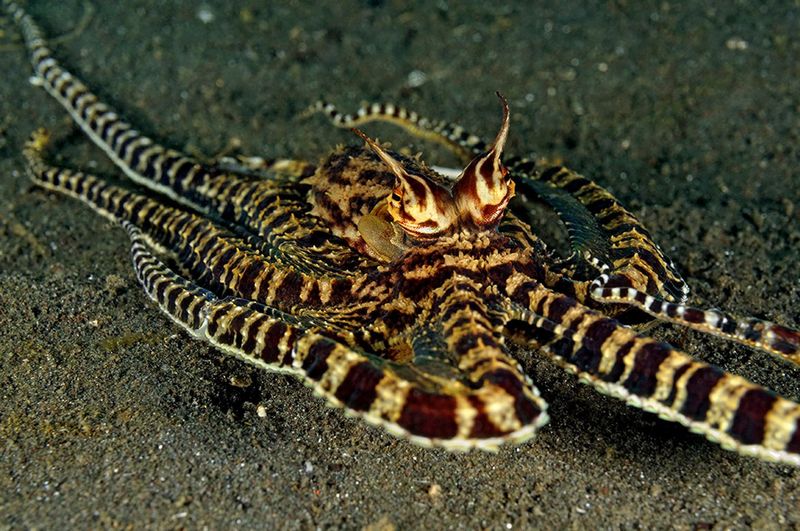
Among its various impersonations, the Mimic Octopus can take on the guise of a sea cucumber, known for its elongated body and leathery appearance. By elongating its own body and adopting a slow, undulating movement, it can convincingly replicate this often-overlooked marine creature.
This mimicry allows the octopus to move undetected across the ocean floor, as sea cucumbers are generally not targeted by predators due to their unappetizing texture and taste. By mimicking the sea cucumber’s movements, the octopus effectively avoids drawing attention to itself.
The sea cucumber imitation is a strategic choice for the Mimic Octopus, showcasing its ability to exploit the less appealing aspects of marine life to ensure its own survival. This tactic highlights the octopus’s ingenuity in navigating its complex underwater world.
13. Brittle Star
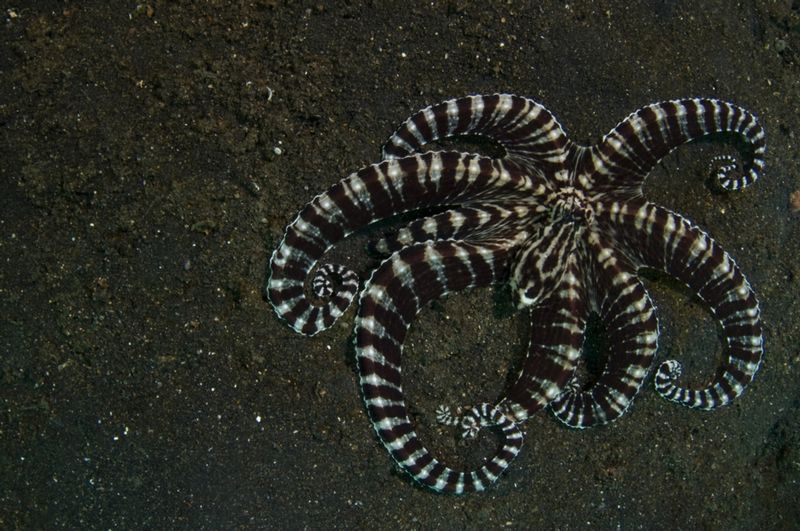
The Mimic Octopus’s ability to imitate a brittle star is a fascinating example of its mimicry skills. By arranging its arms into a star-like pattern and undulating them like the brittle star’s slender limbs, the octopus can closely resemble this star-shaped echinoderm.
This imitation is particularly effective in rocky environments where brittle stars are common. The octopus not only matches the appearance but also simulates the brittle star’s crawling movements, adding authenticity to its disguise.
Imitating a brittle star allows the Mimic Octopus to blend in seamlessly with its surroundings, reducing the likelihood of detection by predators. This clever mimicry strategy highlights the octopus’s versatility in adapting to different environments and exploiting the behaviors of other sea creatures.
14. Hermit Crab
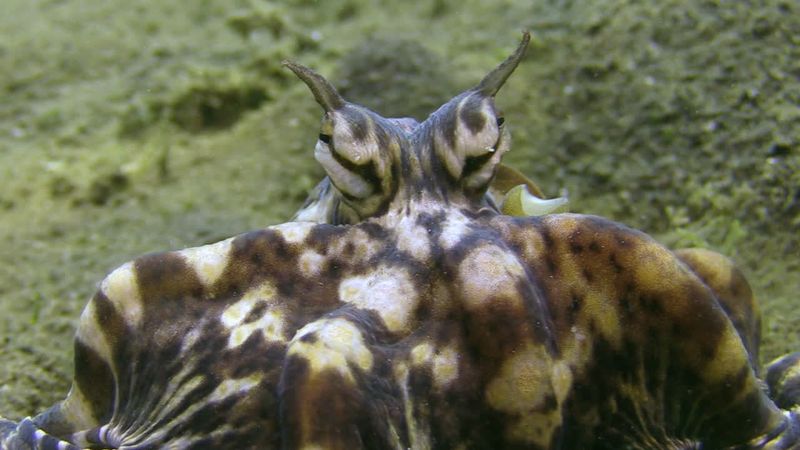
In its array of disguises, the Mimic Octopus can replicate a hermit crab. By curling up and adopting the appearance of a shell with protruding limbs, it can mimic the hermit crab’s unique form.
This mimicry is more than just visual; the octopus can also imitate the hesitant, cautious movements of a hermit crab, enhancing its disguise. This form of imitation allows the octopus to move about undisturbed in areas where hermit crabs are prevalent.
The hermit crab imitation is a strategic choice, as these crabs are often overlooked by predators due to their protective shells. This mimicry underscores the Mimic Octopus’s ability to use the natural defenses of other organisms to its advantage, ensuring its survival in diverse marine habitats.
15. Nudibranch
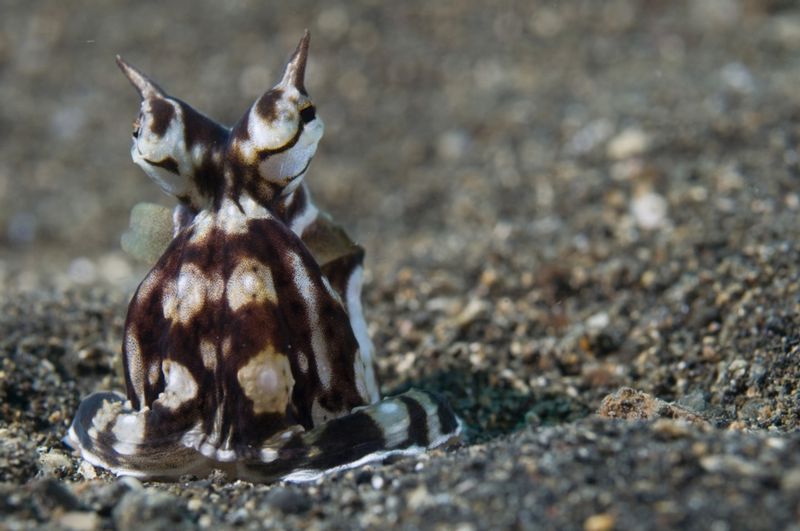
The Mimic Octopus can also take on the appearance of a nudibranch, a type of sea slug known for its colorful and intricate patterns. By altering its skin texture and color, the octopus can become a convincing replica of these vibrant creatures.
This form of mimicry is particularly useful in coral reef environments, where nudibranchs are commonly found. The octopus mimics the nudibranch’s slow, deliberate movements, blending in with the reef’s vivid landscape.
Imitating a nudibranch offers the Mimic Octopus a unique advantage, as these sea slugs often contain toxins that deter predators. By adopting their appearance, the octopus can capitalize on the natural defenses of nudibranchs, ensuring it remains safe in its colorful underwater world.
16. Shrimp
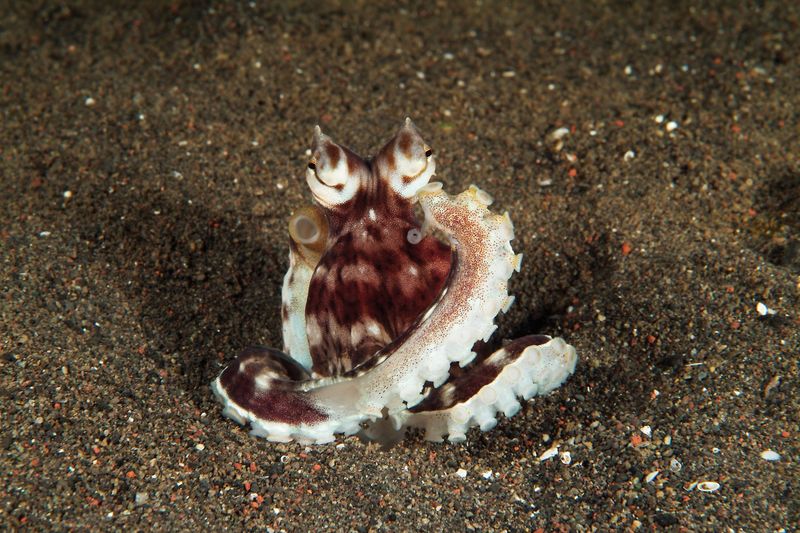
Among its many talents, the Mimic Octopus can imitate a shrimp, a common and agile inhabitant of the ocean. By manipulating the color and texture of its skin, it can resemble the translucent body and appendages of a shrimp.
This form of mimicry includes not only the appearance but also the quick, darting movements characteristic of shrimp. These movements are crucial for the octopus to convincingly mimic the shrimp’s behavior and avoid detection by predators.
The ability to imitate a shrimp allows the Mimic Octopus to navigate coral reefs and other complex environments with ease, using the shrimp’s reputation for speed and agility to its advantage. This imitation underscores the octopus’s ability to adapt its mimicry to a wide range of marine life forms.
17. Scorpionfish
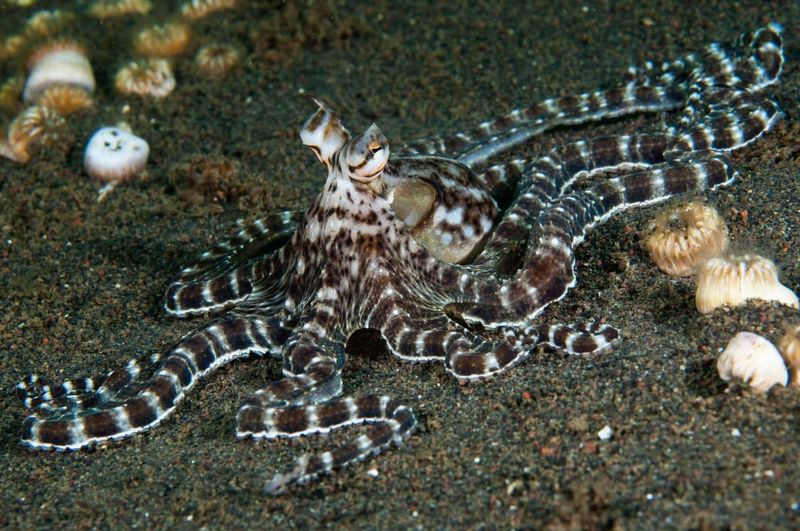
The Mimic Octopus can also take on the guise of a scorpionfish, a master of camouflage with a spiny body and mottled skin. By altering its own skin texture and color patterns, it can blend in seamlessly with rocky substrates.
This imitation is more than visual; the octopus can also mimic the scorpionfish’s slow, deliberate movements, adding authenticity to its disguise. Scorpionfish are often avoided by predators due to their venomous spines, making this mimicry an effective defense strategy.
The scorpionfish imitation allows the Mimic Octopus to exploit the natural defenses of this camouflaged predator, ensuring its own safety in the diverse and competitive ocean environment. This ability highlights the octopus’s strategic use of mimicry to enhance its survival.
18. Squid
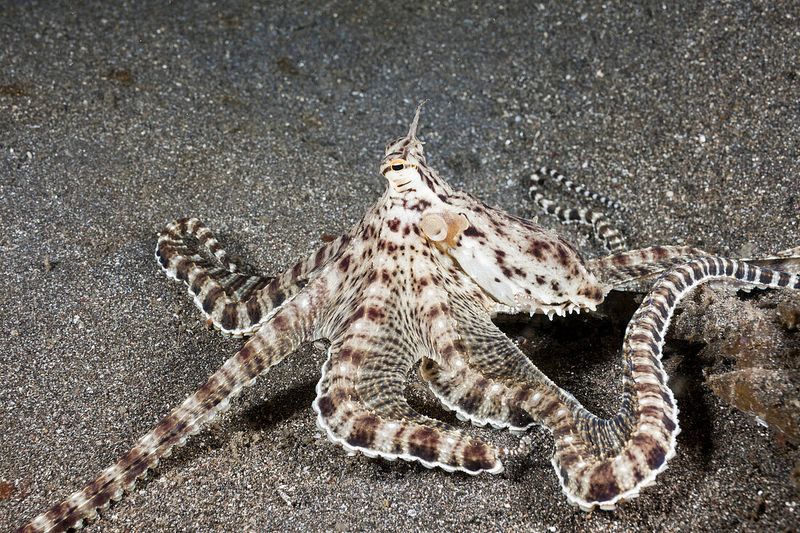
The Mimic Octopus can also imitate a squid, a fellow cephalopod known for its streamlined body and rapid movements. By altering its shape and texture, the octopus can resemble a squid’s sleek form.
This mimicry includes replicating the squid’s dynamic swimming style, which involves quick bursts of speed and agile turns. These movements are crucial for the octopus to convincingly pass as a squid and navigate the ocean’s open waters.
The squid imitation allows the Mimic Octopus to exploit the natural grace and agility of squids, giving it an advantage in avoiding predators and exploring new territories. This ability demonstrates the octopus’s innovative use of mimicry to adapt to different marine environments.



